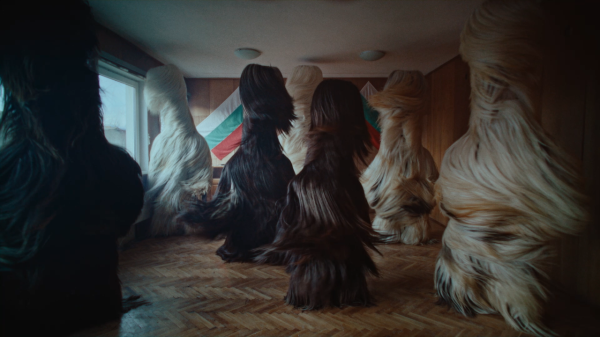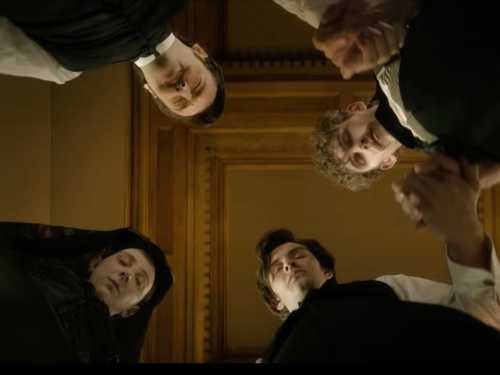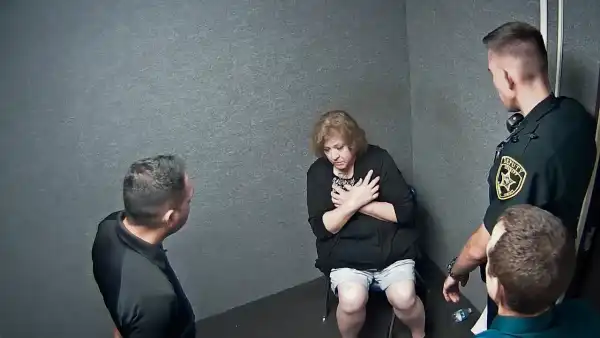
The Kukeri custom extends back centuries, so far into the past that its origins are obscure.
“Kukeri” ’s opening shots are as breathtaking as they are strange. In an office space, hulking figures with tall, cylindrical heads stand motionless, almost brushing against the ceiling. They are covered all over with hair that seems too long to be called fur, and they look as if they’re waiting—for what, we’re not sure. In the shots that follow, we see more of these beings: gathered in a structure that resembles a spaceship made of stone; standing in the snow, staring back at us. A score composed of swelling, overlapping voices lends an air of spirituality. Onscreen, text informs us that “Kukeri is a centuries-old Bulgarian tradition intended to drive away evil spirits.”
The film’s director, Killian Lassablière, told me in an e-mail that he wanted to re-create “that enigmatic and otherworldly feeling I got when I first discovered the tradition.” He’d stumbled on it one day while looking through a series, titled “Wilder Mann,” by the French photographer Charles Fréger. The project featured striking images of masquerade rituals throughout Europe, many of which have pre-Christian roots; the Kukeri tradition, with its imposing costumes, in particular caught Lassablière’s attention. Every year, as winter gives way to spring, men in Bulgarian villages don giant costumes and dance together, whirling and clanging bells to chase off unfriendly spirits and welcome a fruitful year. In one of Fréger’s photos, the hair of the dancer’s outfit—often goat or sheep fur—is caught mid-movement, as the Kukeri twists and thrashes in a dance. In others, toothed masks, peppered with horns, hide their faces, and we can see the heavy bells they hang around their midsections. Lassablière spent months planning, visiting villages in Bulgaria, researching, conducting interviews. By contrast, filming was squeezed into five days in late February and early March, 2022, during which the director and his team hustled to seven different villages and met with more than forty Kukeri. “Everywhere you turn, your camera seems to have a story to tell,” the director wrote, of the experience. Deserted Soviet-era monuments punctuated the landscape, as did “countryside houses filled with life and texture.” For interviews, many Kukeri invited Lassablière and his team into their homes, where masks and bells hung on the walls, and there was “always a bottle of homemade rakia”—fruit brandy—“on the table.”
Throughout the film, there’s a determined focus on the concept of legacy. “If you do not believe in something,” one of the interviewees says, in voice-over, “it cannot exist.” Traditions survive by being transmitted from generation to generation, like genes. Contained in this idea of passing things on is the concept that one can outlive oneself—of life not as finite but as part of a continuum. And there is some truth to this; the Kukeri custom extends back centuries, so far into the past that its origins are obscure. Lassablière said that he wanted to reflect that in the film’s audio. The thrumming, skittering soundtrack is inspired by “The Mystery of the Bulgarian Voices,” an album that features recordings of Bulgarian folk songs. “There’s something visceral about it,” he wrote, of the traditional style of singing. “It feels sacred.” Paired with the importance of legacy is the importance of togetherness—in one section of the documentary, we see old Kukeri and young Kukeri, girls and boys, stand or dance onscreen, together, all clad in their fur-drenched outfits—“leathers,” as they’re called in the film. A woman describes what it is, exactly, that Kukeri try to scare away with their dancing: “Evil is poverty,” she says. “No wheat, corn, potatoes to eat.” She says, also, “Evil is when we don’t want to be together.”
In some ways, it seems miraculous that the custom has survived as long as it has, through the Ottoman occupation of Bulgaria, and, later, forced-labor camps under Communist rule. “Many new regimes have tried to stamp out the practice,” the onscreen text reads, near the end of the film. Perhaps that’s why such a large focus in the documentary is survival, not just for individuals but for generations—the question of how long a group of people can retain what makes them, them. In spite of the forces that have sought to end it, this particular tradition has managed to persist throughout recorded history, and it doesn’t show signs of disappearing soon. The number of Kukeri at Surva, the annual festival at which they dance, has increased since it began in 1966. In his e-mail to me, Lassablière wondered if the hardships of the past had only served to fortify the bond among the Kukeri. “The more challenges you’ll be faced with, the stronger the need for community,” he mused. “It is simple and universal.”
Sourse: newyorker.com






